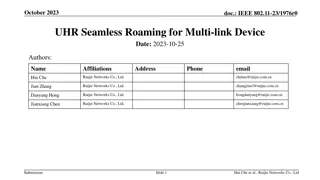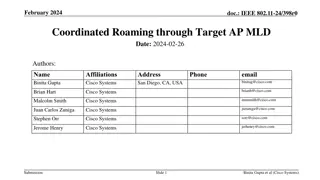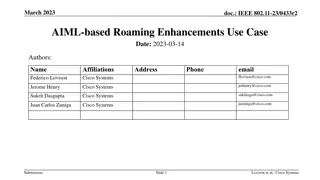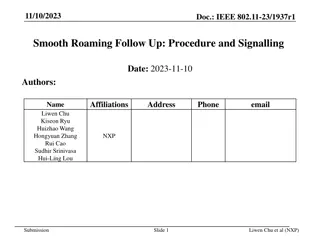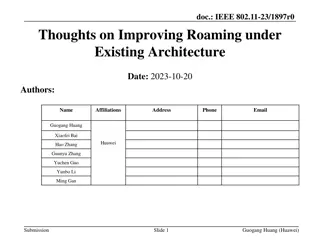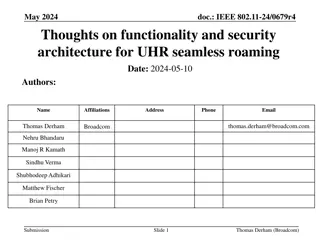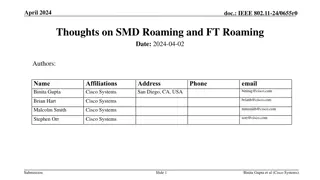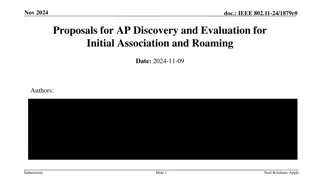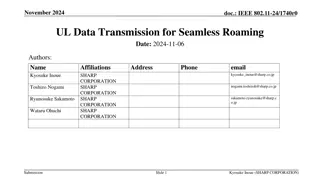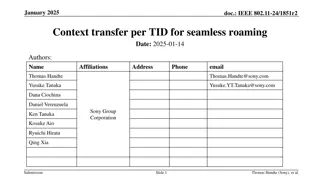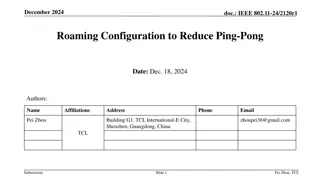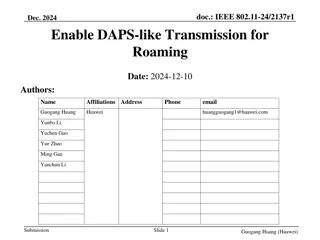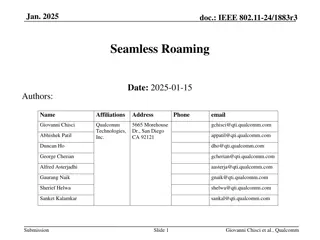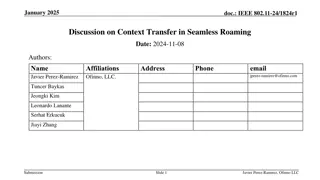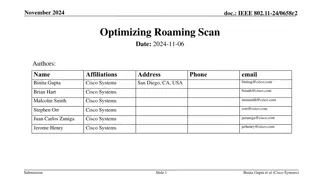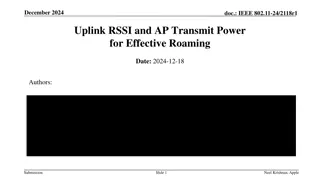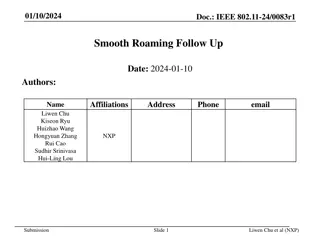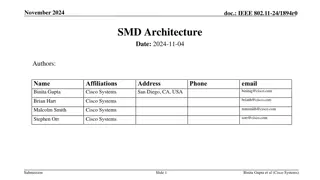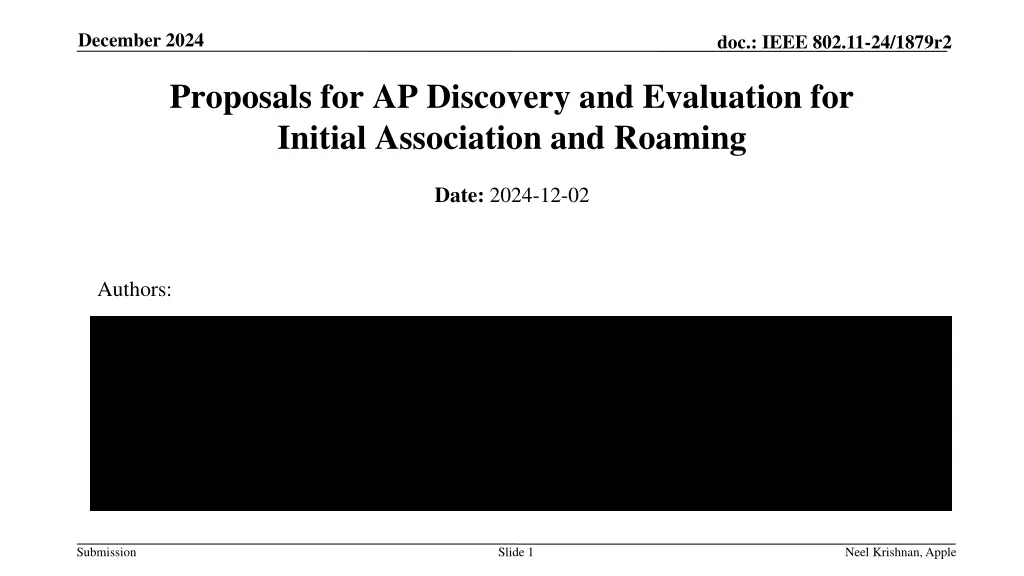
Efficient AP Discovery and Evaluation Proposals
Explore proposals for efficient discovery and evaluation of neighborhood APs by client devices to enhance initial association and roaming processes in IEEE 802.11 networks. The document discusses considerations to streamline AP discovery, reduce latency, and minimize power consumption for Non-AP devices. Key ideas include utilizing associated APs to request information about neighboring APs and implementing fast OTA scanning techniques. Discover how these strategies aim to improve the AP selection process and enhance network connectivity.
Download Presentation

Please find below an Image/Link to download the presentation.
The content on the website is provided AS IS for your information and personal use only. It may not be sold, licensed, or shared on other websites without obtaining consent from the author. If you encounter any issues during the download, it is possible that the publisher has removed the file from their server.
You are allowed to download the files provided on this website for personal or commercial use, subject to the condition that they are used lawfully. All files are the property of their respective owners.
The content on the website is provided AS IS for your information and personal use only. It may not be sold, licensed, or shared on other websites without obtaining consent from the author.
E N D
Presentation Transcript
December 2024 doc.: IEEE 802.11-24/1879r2 Proposals for AP Discovery and Evaluation for Initial Association and Roaming Date: 2024-12-02 Authors: Submission Slide 1 Neel Krishnan, Apple
December 2024 doc.: IEEE 802.11-24/1879r2 Abstract Discuss some considerations and proposals to facilitate effective and expedited discovery of neighborhood APs by a client device (Non-AP STA) for initial association and roaming. Submission Slide 2 Neel Krishnan, Apple
December 2024 doc.: IEEE 802.11-24/1879r2 Motivation Discovery and evaluation of neighbor APs / AP MLDs by a Non-AP device is a crucial component in choosing target APs for initial association / roaming Conventionally, a Non-AP device performs autonomous OTA channel scans (active / passive) to discover neighbor APs / AP MLDs o OTA channel scans are expensive in time and power consumption; executing channel scans in 2.4/5/6 GHz bands may take a few seconds to complete o OTA scanning disrupts low latency transmission Adds delays to low latency transmissions o Complete Beacon or Probe Response content is available to evaluate whether a discovered AP is suitable as a roaming target AP. The Beacon / Probe Response contains many unnecessary parameters Hence, it is desirable to devise schemes to efficiently discover neighbor APs / AP MLDs by a Non-AP: o Data radio is available all the time for data transmissions, no additional delays caused by OTA scanning o non-AP STA power consumption is minimized Key idea An associated AP (referred to as Reporting AP) provides necessary information of (non-co-located) neighbor APs / AP MLDs to a Requesting Non-AP STA Non-associated STAs request neighbor AP parameters by sending a probe request requesting neighbor parameters to the Reporting AP Submission Slide 3 Neel Krishnan, Apple
December 2024 doc.: IEEE 802.11-24/1879r2 Overarching Goal Key takeaway A Non-AP can discover multiple neighbor APs, obtain relevant information about the APs, and create / maintain candidate AP(s) with a single frame exchange with Reporting AP Submission Slide 4 Neel Krishnan, Apple
December 2024 doc.: IEEE 802.11-24/1879r2 Fast OTA Scanning A STA obtains all required AP parameters from serving AP STA does not perform OTA scanning for the AP, only OTA DL RSSI measurement is needed STA minimizes the OTA operation duration at the neighbor AP channel Proposal: STA uses RTS-CTS frames to measure DL RSSI from Reported APs RTS-CTS are Class-1 control frames that can be exchanged between a STA and an unassociated (and unauthenticated) AP STA sends RTS to APNeighbor;STA measures RSSI APNeighbor STA from the CTS response Benefits: Simple framework, supported in current standards Overhead of RSSI measurement is minimal; ~100s of microseconds per neighbor AP; maximized availability for the associated AP Similar RSSI measurement accuracy as beacon / probe response frames; RSSI measured over the preamble (L-LTF field) of the frames (in the PHY header) and all these frames are transmitted with robust rates o o o o o o o Submission Slide 5 Neel Krishnan, Apple
December 2024 doc.: IEEE 802.11-24/1879r2 Time Delay Between Request and Response (1) Goal of the proposed framework STA receives information about neighbor non-co-located APs through the Reporting AP without incurring a significant delay o Time delay between a request from Client device and a response from Reporting AP should not be inordinately high As the delay grows higher, the benefits of getting parameters through associated AP are diluted since STA will perform legacy OTA active scans o For example, we have observed time delay in the order of hundreds of milliseconds between when a Client device issues a BTM Query and when Reporting AP responds with a BTM Request Submission Slide 6 Neel Krishnan, Apple
December 2024 doc.: IEEE 802.11-24/1879r2 Time Delay Between Request and Response (2) Proposal: The Reporting AP has an upper bound on the time delay between Request for Neighbor AP information and the corresponding Response o The upper bound on this delay may be in the order of tens of milliseconds (exact value is TBD) o This delay is specified in 802.11 spec and tested in Wi-Fi Alliance If the delay is stringent, the Reporting AP may provide cached information about Neighbor AP(s) to meet the delay bound o This may be acceptable since static information about Neighbor AP(s) is useful and likely not change over time o Fast response should the primary goal o If the dynamic information about Neighbor AP(s) is indeed old, it can be reflected in a metric that quantifies the age of such information o Client may perform appropriate actions based on the age; for example, perform directed scans for those Neighbor AP(s) for which the information is old, etc. Submission Slide 7 Neel Krishnan, Apple
December 2024 doc.: IEEE 802.11-24/1879r2 Motivation Content of Discovery Information Some mechanisms already exist in baseline spec that somewhat address our goal: o Reduced Neighbor Report (RNR) o Neighbor Report in BSS Transition Management o Multi-link Probe Request / Response However, a few key limitations exist for the existing schemes, as described below: o Information contained is either too little (forcing Non-AP to perform additional OTA channel scans) or too much (resulting in wastage of precious medium airtime) o Reporting AP includes information about only those APs that are co-located with the same AP MLD as the Reporting AP (a behavior that we have observed in the field, even though spec does not impose such a limitation) Objectives and Targets of the discovery information content: o Communicate information about non-co-located neighboring APs / AP MLDs in response to a Request received from a Requesting Non-AP STA o Identify a minimum set of attributes that are relevant for initial link setup / roaming and communicate only that set to the Requesting Non-AP to minimize overhead The minimum set will serve associated and non-associated STAs Due to non-AP STA privacy reasons, non-associated STAs cannot request parameters clear OTA It is better to get complete set of parameters, if the desired minimum set of parameters is not available Slide 8 Submission Neel Krishnan, Apple
December 2024 doc.: IEEE 802.11-24/1879r2 Key Considerations The Reporting AP provides the information about neighbor APs / AP MLDs only in response to a request received from a Non-AP o We do not envision this information to be carried always in Beacons, etc., of the Reporting AP, which may otherwise result in gratuitous bloating of such frames The response from the Reporting AP contains only those attributes about neighboring APs / AP MLDs that are necessary for a Non-AP to perform candidate AP selection for initial link setup, roaming, etc. o A client device likely does not need the full information about neighbor APs / AP MLDs (present in Beacons / Probe Response frames) to perform selection of candidate AP(s) for initial association / roaming The content of the response from the Reporting AP should be applicable to both unassociated and associated client devices o The information may be carried in any frame Probe Response, (unsolicited) BTM Request, etc. sent by the Reporting AP o The attributes of interest to a Non-AP for evaluation of neighbor APs / AP MLDs are listed in the next slide The response from the Reporting AP may include information about legacy (pre-11bn) neighbor APs / AP MLDs, in addition to 11bn AP MLDs o Providing such information is useful for a Non-AP, especially in the context of initial association Submission Slide 9 Neel Krishnan, Apple
December 2024 doc.: IEEE 802.11-24/1879r2 Modified RNR Format (Example) Example of how Reduced Neighbor Report (RNR) can be updated to carry relevant information about neighbor APs / AP MLDs TBTT Information Field Type = 0, Length subfield = 23 (currently reserved in 11be) TBTT Offset (1 byte) BSSID (6 bytes) Short SSID (4 bytes) Neighbor AP Static Attributes (5 bytes) o Co-located o PHY Type o Security Protocol Support Bitmap o IP Address Continuity o Highest NSS o UPR Active o 20 MHz PSD Neighbor AP Dynamic Attributes (4 bytes) o BSS Operating BW o Channel Utilization + Station Count o Association Disallowed o Timestamp of Information Collection AP MLD ID (1 byte) SMD ID (1 byte) or Same SMD ID (1 bit) Proposed new fields to be added to the existing RNR element Submission Slide 10 Neel Krishnan, Apple
December 2024 doc.: IEEE 802.11-24/1879r2 Security Protocol Support of Neighbor APs Goal: Communicate the security protocol (WPA3, WPA2, etc.) supported by each Neighbor / Reported AP o WPA2, WPA3, etc., are terms used by the Wi-Fi Alliance; need to indicate the corresponding AKM Suite Selector(s) for each Reported AP A Client device typically uses security protocol supported by discovered APs / networks to evaluate them for favorability for initial association and roaming o Example order of preference: Enterprise > PSK > Open, WPA3 > WPA2 > WPA > WEP An AP may indicate support for several AKM Suites in RSN element; each AKM Suite is represented using 4 octets (see figure below) Signaling all supported AKM suites (N) entails a high overhead (4*N octets) To rank/evaluate/select candidate APs, knowledge of security protocols / AKM Suites supported by Neighbor AP(s) should suffice Problem Statement: Efficiently communicate the list of AKM Suites supported by each neighbor AP RSNE format Submission Slide 11 Neel Krishnan, Apple
December 2024 doc.: IEEE 802.11-24/1879r2 Proposal: Security Protocol Support Bitmap AKM Suite ID (Table 9-190 in REVme_D7.0) Security Protocol ID Wi-Fi Security Protocol Assign a unique ID (named Security Protocol ID) that identifies an AKM Suite supported by the Reported AP Reporting AP includes a bitmap (3 octets) named Security Protocol Support Bitmap for each Reported AP Set 1 for each bit position (starting from LSB) corresponding to the Security Protocol ID(s) supported by the Reported AP Example: Security Protocol Support Bitmap set as 0x8 0x8 01010101 Reported AP supports WPA2-Enterprise (with and without FT), WPA3-Personal (with and without FT) Set Security Protocol Support Bitmap as all 0s if the Reported AP does not support any of the listed security protocols Client device can deduce the AKM Suite(s) supported by the Reported AP by inspecting the bitmap WPA-Enterprise / WPA2-Enterprise (802.1X) 1 00-0f-ac-01 WPA-Personal / WPA2-Personal (PSK) 2 00-0f-ac-02 WPA2-Enterprise with FT (802.1X + FT) 3 00-0f-ac-03 4 WPA2-Personal with FT (PSK + FT) 00-0f-ac-04 5 WPA3-Personal (SAE) 00-0f-ac-08 6 WPA3-Enterprise (SAE) 00-0f-ac-12 7 WPA3-Personal with FT (SAE + FT) 00-0f-ac-09 8 WPA3-Enterprise with FT 00-0f-ac-13 9 WPA3-Enterprise Suite-B (192 bit) 00-0f-ac-14 WPA3-Enterprise Suite-B (192 bit) with FT 10 00-0f-ac-24 Opportunistic Wireless Encryption (OWE) 11 00-0f-ac-25 Submission Slide 12 Neel Krishnan, Apple
December 2024 doc.: IEEE 802.11-24/1879r2 Freshness of Information About Reported AP(s) Desirable for Non-AP STA to know when information about AP #n was collected, along with the relevant attributes Submission Slide 13 Neel Krishnan, Apple
December 2024 doc.: IEEE 802.11-24/1879r2 Proposal: Timestamp of Information Collection and Updated Attributes Bitmap Add an attribute named Age of Information Collection for each Reported AP Age of Information Collection is the number of TBTTs since one or more of the Dynamic Attributes of the Reported AP were obtained from the reported AP: o Channel Utilization + STA Count (as in BSS Load element) o Association Disallowed o BSS Parameters Change Count Timestamp value may be in units of 5 Beacon intervals to allow relaxed information updates for the APs Submission Slide 14 Neel Krishnan, Apple
December 2024 doc.: IEEE 802.11-24/1879r2 Conclusion The purpose of this contribution is many-fold: o Highlight the benefits of obtaining non-co-located neighbor APs / AP MLDs information through the serving AP o Minimized OTA scanning time with fast RSSI measurements between Non-AP and the Reported APs Lower delays for low-latency traffic Reduced non-AP STA power consumption o Clearly spell out requirements to make the scheme relevant for non-AP STAs Fast responses No need for additional OTA scanning Indicate the age of information collection for each Reported AP o Identify a set of attributes that are relevant to Non-AP to choose target AP(s) for initial association / roaming and include only those attributes in the response from Reporting AP Such information aids client devices in making educated decisions during initial-link-setup, roaming, etc., while entailing minimal overhead Submission Slide 15 Neel Krishnan, Apple
December 2024 doc.: IEEE 802.11-24/1879r2 Straw Poll Do you support that an AP (referred to as Reporting AP) communicates information it has about non-co-located neighbor APs / AP MLDs (referred to as Reported APs) in response to a request received from a Non-AP device to help the Non-AP device in discovery and evaluation of the Reported APs as targets for initial association / roaming? Note: The Non-AP device requesting such information may or may not be associated with the Reporting AP Y: N: A: Submission Slide 16 Neel Krishnan, Apple
December 2024 doc.: IEEE 802.11-24/1879r2 APPENDIX: Relevant Attributes of Neighbor APs / AP MLDs Assumption Reporting AP may be aware of Legacy AP(s) in its neighborhood, not just 11bn AP MLD(s) Roaming Phase Attributes of interest TBTT Offset BSSID Short SSID Co-located AP Notes Client may receive Beacon from Reported AP, if needed Identity of the Reported AP Reported AP is co-located (or not) with the Reporting AP IP Address Continuity Client can maintain the same IP address when moving from Reporting AP to Reported AP Discovery UPR Active Client may receive UPR from Reported AP in 6 GHz, if needed Governs the transmit power of the Non-AP when transmitting frames to the Reported AP prior to association 20 MHz PSD AP MLD ID Identity of AP MLD with which the Reported 11be AP is affiliated Identity of the Seamless Mobility Domain (SMD) to which the Reported 11bn AP is affiliated SMD ID PHY Type (11bn, 11be, 11ax, ) BSS Operating BW Highest NSS BSS Load + STA Count Estimate achievable DL throughput from Reported AP Evaluation Association Disallowed Eliminate Reported AP as a candidate if association is disallowed Security Protocol Support (Support of AKM Suites) Indicate the security protocols / AKM suites supported by the Reported AP Submission Slide 17 Neel Krishnan, Apple

